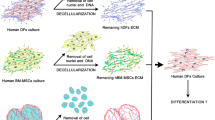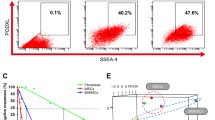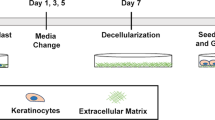Abstract
Reprogramming of somatic cells to induced pluripotent stem cells (iPSC) provides an important cell source to derive patient-specific cells for potential therapeutic applications. However, it is not yet clear whether reprogramming through pluripotency allows the production of differentiated cells with improved functional properties that may be beneficial in regenerative therapies. To address this, we compared the production and assembly of extracellular matrix (ECM) by iPSC-derived fibroblasts to that of the parental, dermal fibroblasts (BJ), from which these iPSC were initially reprogrammed, and to fibroblasts differentiated from human embryonic stem cells (hESC). iPSC- and hESC-derived fibroblasts demonstrated stable expression of surface markers characteristic of stromal fibroblasts during prolonged culture and showed an elevated growth potential when compared to the parental BJ fibroblasts. We found that in the presence of l-ascorbic acid-2-phosphate, iPSC- and hESC-derived fibroblasts increased their expression of collagen genes, secretion of soluble collagen, and extracellular deposition of type I collagen to a significantly greater degree than that seen in the parental BJ fibroblasts. Under culture conditions that enabled the self-assembly of a 3D stromal tissue, iPSC- and hESC-derived fibroblasts generated a well organized, ECM that was enriched in type III collagen. By characterizing the functional properties of iPSC-derived fibroblasts compared to their parental fibroblasts, we demonstrate that these cells represent a promising, alternative source of fibroblasts to advance future regenerative therapies.





Similar content being viewed by others
References
Chang H. Y.; Chi J. T.; Dudoit S.; Bondre C.; van de Rijn M.; Botstein D.; Brown P. O. Diversity, topographic differentiation, and positional memory in human fibroblasts. Proc Natl Acad Sci USA 99: 12877–12882; 2002.
Chojkier M.; Houglum K.; Solis-Herruzo J.; Brenner D. A. Stimulation of collagen gene expression by ascorbic acid in cultured human fibroblasts. A role for lipid peroxidation? J Biol Chem 264: 16957–16962; 1989.
Falanga V. Wound healing and its impairment in the diabetic foot. Lancet 366: 1736–1743; 2005.
Galkowska H.; Wojewodzka U.; Olszewski W. L. Chemokines, cytokines, and growth factors in keratinocytes and dermal endothelial cells in the margin of chronic diabetic foot ulcers. Wound Repair Regen: official publication of the Wound Healing Society [and] the European Tissue Repair Society 14: 558–565; 2006.
Grainger S. J.; Putnam A. J. Assessing the permeability of engineered capillary networks in a 3D culture. PLoS One 6: e22086; 2011.
Gurkan U. A.; Cheng X.; Kishore V.; Uquillas J. A.; Akkus O. Comparison of morphology, orientation, and migration of tendon derived fibroblasts and bone marrow stromal cells on electrochemically aligned collagen constructs. J Biomed Mater Res A 94: 1070–1079; 2010.
Haniffa M. A.; Wang X. N.; Holtick U.; Rae M.; Isaacs J. D.; Dickinson A. M.; Hilkens C. M.; Collin M. P. Adult human fibroblasts are potent immunoregulatory cells and functionally equivalent to mesenchymal stem cells. J Immunol 179: 1595–1604; 2007.
Hata R.; Senoo H. l-ascorbic acid 2-phosphate stimulates collagen accumulation, cell proliferation, and formation of a three-dimensional tissuelike substance by skin fibroblasts. J Cell Physiol 138: 8–16; 1989.
Hewitt K. J.; Shamis Y.; Carlson M. W.; Aberdam E.; Aberdam D.; Garlick J. A. Three-dimensional epithelial tissues generated from human embryonic stem cells. Tissue Eng Part A 15: 3417–3426; 2009.
Hewitt K. J.; Shamis Y.; Hayman R. B.; Margvelashvili M.; Dong S.; Carlson M. W.; Garlick J. A. Epigenetic and phenotypic profile of fibroblasts derived from induced pluripotent stem cells. PLoS One 6: e17128; 2011.
Klimanskaya I.; Rosenthal N.; Lanza R. Derive and conquer: sourcing and differentiating stem cells for therapeutic applications. Nat Rev Drug Discov 7: 131–142; 2008.
Koumas L.; King A. E.; Critchley H. O.; Kelly R. W.; Phipps R. P. Fibroblast heterogeneity: existence of functionally distinct Thy 1(+) and Thy 1(−) human female reproductive tract fibroblasts. Am J Pathol 159: 925–935; 2001.
Lapasset L.; Milhavet O.; Prieur A.; Besnard E.; Babled A.; Ait-Hamou N.; Leschik J.; Pellestor F.; Ramirez J. M.; De Vos J.; Lehmann S.; Lemaitre J. M. Rejuvenating senescent and centenarian human cells by reprogramming through the pluripotent state. Genes Dev 25: 2248–2253; 2011.
Lian Q.; Lye E.; Suan Yeo K.; Khia Way Tan E.; Salto-Tellez M.; Liu T. M.; Palanisamy N.; El Oakley R. M.; Lee E. H.; Lim B.; Lim S. K. Derivation of clinically compliant MSCs from CD105+, CD24- differentiated human ESCs. Stem Cells 25: 425–436; 2007.
Lian Q.; Zhang Y.; Zhang J.; Zhang H. K.; Wu X.; Lam F. F.; Kang S.; Xia J. C.; Lai W. H.; Au K. W.; Chow Y. Y.; Siu C. W.; Lee C. N.; Tse H. F. Functional mesenchymal stem cells derived from human induced pluripotent stem cells attenuate limb ischemia in mice. Circulation 121: 1113–1123; 2010.
Liu H.; Kim Y.; Sharkis S.; Marchionni L.; Jang Y. Y. In vivo liver regeneration potential of human induced pluripotent stem cells from diverse origins. Sci Transl Med 3: 82ra39; 2011.
Loot M. A.; Kenter S. B.; Au F. L.; van Galen W. J.; Middelkoop E.; Bos J. D.; Mekkes J. R. Fibroblasts derived from chronic diabetic ulcers differ in their response to stimulation with EGF, IGF-I, bFGF and PDGF-AB compared to controls. Eur J Cell Biol 81: 153–160; 2002.
Maherali N.; Ahfeldt T.; Rigamonti A.; Utikal J.; Cowan C.; Hochedlinger K. A high-efficiency system for the generation and study of human induced pluripotent stem cells. Cell Stem Cell 3: 340–345; 2008.
Marion R. M.; Blasco M. A. Telomeres and telomerase in adult stem cells and pluripotent embryonic stem cells. Adv Exp Med Biol 695: 118–131; 2010.
Murad S.; Grove D.; Lindberg K. A.; Reynolds G.; Sivarajah A.; Pinnell S. R. Regulation of collagen synthesis by ascorbic acid. Proc Natl Acad Sci USA 78: 2879–2882; 1981.
Namazi M. R.; Fallahzadeh M. K.; Schwartz R. A. Strategies for prevention of scars: what can we learn from fetal skin? Int J Dermatol 50: 85–93; 2011.
Peterkofsky B. The effect of ascorbic acid on collagen polypeptide synthesis and proline hydroxylation during the growth of cultured fibroblasts. Arch Biochem Biophys 152: 318–328; 1972.
Phan S. H. Biology of fibroblasts and myofibroblasts. Proc Am Thorac Soc 5: 334–337; 2008.
Pouyani T.; Ronfard V.; Scott P. G.; Dodd C. M.; Ahmed A.; Gallo R. L.; Parenteau N. L. De novo synthesis of human dermis in vitro in the absence of a three-dimensional scaffold. In vitro cellular & developmental biology. Animal 45: 430–441; 2009.
Proulx S.; d’Arc Uwamaliya J.; Carrier P.; Deschambeault A.; Audet C.; Giasson C. J.; Guerin S. L.; Auger F. A.; Germain L. Reconstruction of a human cornea by the self-assembly approach of tissue engineering using the three native cell types. Mol Vis 16: 2192–2201; 2010.
Schmidt D.; Hoerstrup S. P. Tissue engineered heart valves based on human cells. Swiss Med Wkly 136: 618–623; 2006.
Schultz G. S.; Wysocki A. Interactions between extracellular matrix and growth factors in wound healing. Wound Repair Regen: official publication of the Wound Healing Society [and] the European Tissue Repair Society 17: 153–162; 2009.
Shamis Y.; Hewitt K. J.; Carlson M. W.; Margvelashvilli M.; Dong S.; Kuo C. K.; Daheron L.; Egles C.; Garlick J. A. Fibroblasts derived from human embryonic stem cells direct development and repair of 3D human skin equivalents. Stem Cell Res Ther 2: 10; 2011.
Sorrell J. M.; Baber M. A.; Caplan A. I. Clonal characterization of fibroblasts in the superficial layer of the adult human dermis. Cell Tissue Res 327: 499–510; 2007.
Sorrell J. M.; Baber M. A.; Caplan A. I. Human dermal fibroblast subpopulations; differential interactions with vascular endothelial cells in coculture: nonsoluble factors in the extracellular matrix influence interactions. Wound Repair Regen: official publication of the Wound Healing Society [and] the European Tissue Repair Society 16: 300–309; 2008.
Sorrell J. M.; Caplan A. I. Fibroblast heterogeneity: more than skin deep. J Cell Sci 117: 667–675; 2004.
Sottile J.; Shi F.; Rublyevska I.; Chiang H. Y.; Lust J.; Chandler J. Fibronectin-dependent collagen I deposition modulates the cell response to fibronectin. Am J Physiol Cell Physiol 293: C1934–C1946; 2007.
Stojkovic P.; Lako M.; Stewart R.; Przyborski S.; Armstrong L.; Evans J.; Murdoch A.; Strachan T.; Stojkovic M. An autogeneic feeder cell system that efficiently supports growth of undifferentiated human embryonic stem cells. Stem Cells 23: 306–314; 2005.
Suhr S. T.; Chang E. A.; Rodriguez R. M.; Wang K.; Ross P. J.; Beyhan Z.; Murthy S.; Cibelli J. B. Telomere dynamics in human cells reprogrammed to pluripotency. PLoS One 4: e8124; 2009.
Suhr S. T.; Chang E. A.; Tjong J.; Alcasid N.; Perkins G. A.; Goissis M. D.; Ellisman M. H.; Perez G. I.; Cibelli J. B. Mitochondrial rejuvenation after induced pluripotency. PLoS One 5: e14095; 2010.
Swistowski A.; Peng J.; Liu Q.; Mali P.; Rao M. S.; Cheng L.; Zeng X. Efficient generation of functional dopaminergic neurons from human induced pluripotent stem cells under defined conditions. Stem Cells 28: 1893–1904; 2010.
Telgenhoff D.; Shroot B. Cellular senescence mechanisms in chronic wound healing. Cell Death Differ 12: 695–698; 2005.
Thomson J. A.; Itskovitz-Eldor J.; Shapiro S. S.; Waknitz M. A.; Swiergiel J. J.; Marshall V. S.; Jones J. M. Embryonic stem cell lines derived from human blastocysts. Science 282: 1145–1147; 1998.
Throm A. M.; Liu W. C.; Lock C. H.; Billiar K. L. Development of a cell-derived matrix: effects of epidermal growth factor in chemically defined culture. J Biomed Mater Res A 92: 533–541; 2010.
Wong T.; McGrath J. A.; Navsaria H. The role of fibroblasts in tissue engineering and regeneration. Br J Dermatol 156: 1149–1155; 2007.
Xu C.; Jiang J.; Sottile V.; McWhir J.; Lebkowski J.; Carpenter M. K. Immortalized fibroblast-like cells derived from human embryonic stem cells support undifferentiated cell growth. Stem Cells 22: 972–980; 2004.
Yamaguchi Y.; Itami S.; Tarutani M.; Hosokawa K.; Miura H.; Yoshikawa K. Regulation of keratin 9 in nonpalmoplantar keratinocytes by palmoplantar fibroblasts through epithelial-mesenchymal interactions. J Invest Dermatol 112: 483–488; 1999.
Acknowledgments
We would like to thank Drs. Nimet Maherali and Konrad Hochedlinger for the BJ-iPSC line and Judith Edwards for help in preparation of this manuscript. This work was supported by grant no. DE017413 to JAG from National Institute for Dental Research (NIDCR).
Conflicts of interest
The authors indicate no potential conflicts of interest.
Author information
Authors and Affiliations
Corresponding author
Additional information
Editor: T. Okamoto
Rights and permissions
About this article
Cite this article
Shamis, Y., Hewitt, K.J., Bear, S.E. et al. iPSC-derived fibroblasts demonstrate augmented production and assembly of extracellular matrix proteins. In Vitro Cell.Dev.Biol.-Animal 48, 112–122 (2012). https://doi.org/10.1007/s11626-011-9478-4
Received:
Accepted:
Published:
Issue Date:
DOI: https://doi.org/10.1007/s11626-011-9478-4




